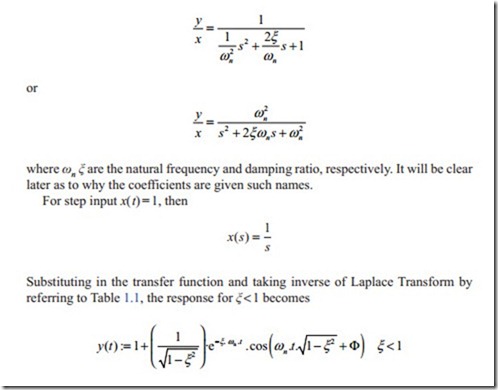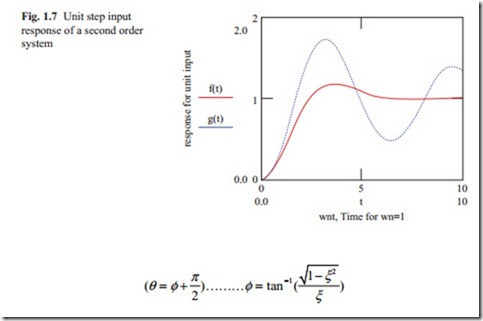Second Order Transfer Function
Standard second order transfer function is written in two ways of
The response is a decaying oscillatory motion, and the rate of decay depends on ξ. The unit step input response for various values of ξ is shown in Fig. 1.7.
The response is overdamped when ξ > 1 and underdamped when ξ < 1. When ξ = 1, the response is overdamped with maximum speed of response. For most con- trol systems, a damping ratio of ξ = 0.7 or ξ = 0.8 is acceptable. For ς = 0.1, ς = 0.5 the response is shown in Fig. 1.7.
For the most complicated control system, the elements of its overall transfer function can be modeled by first or second order transfer function.
The parameters of interest for the second order transfer function are the fre- quency of oscillation and its percentage overshoot for ς < 1.0.
From the response equation, it is clear that the frequency of oscillation is
1 – V 2 . The percentage overshoot can be obtained by first calculating the derivative of the response and equating it to zero. The first peak then can be ob- tained by substituting for time in the response equation. Then the percentage over- shoot ( P.O) is given by
The two parameters defined above can also be used to obtain the transfer function of a system with second order transfer function and for ξ < 1. When the system is overdamped, it is possible to model the system by first order transfer function or to obtain two points on the response and using the response equation to find the natural frequency and the damping ratio.
The frequency response can be obtained similar to the first order system. The amplitude ratio reaches a peak value when approximately ω = ωn. For ς < 1, there is a resonance frequency showing the fact that the response is oscillatory. For ς > 1, the amplitude ratio always is less than 1 showing the fact that the system is over- damped. For exercise, the reader is recommended to obtain the frequency response by replacing s with iω. The reader is also encouraged to obtain the response to a ramp input. The frequency response will be studied at the end of this chapter.



